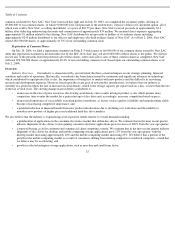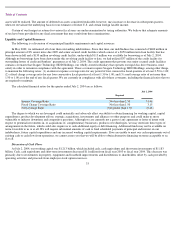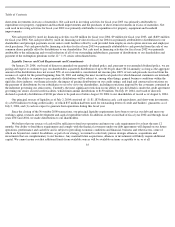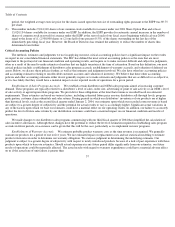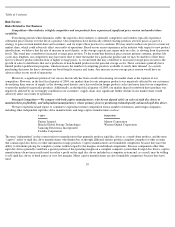Seagate 2003 Annual Report Download - page 33
Download and view the complete annual report
Please find page 33 of the 2003 Seagate annual report below. You can navigate through the pages in the report by either clicking on the pages listed below, or by using the keyword search tool below to find specific information within the annual report.
Table of Contents
of XIOtech in November 2002 and $21 million in the provision for bad debts. These decreases were partially offset by increases of $20 million
in salaries and related costs, $14 million in information technology expense and $7 million in depreciation expense.
Restructuring. During fiscal year 2003, we recorded $19 million in restructuring charges. We also reduced a restructuring accrual
previously recorded by our predecessor in fiscal year 1998 by $10 million due to a change in estimated lease obligations. These combined
actions resulted in a net restructuring charge of $9 million in fiscal year 2003. Of the $19 million, $17 million was incurred in the quarter ended
September 27, 2002 as a result of a restructuring plan, which we refer to as the fiscal year 2003 restructuring plan, established to continue the
alignment of our global workforce and manufacturing capacity with existing and anticipated future market requirements, primarily in our Far
East operations. The restructuring charge was comprised of employee termination costs relating to a reduction in our workforce of
approximately 3,750 employees. We estimate that after completion of the fiscal year 2003 restructuring activities, annual salary expense has
been reduced by approximately $12 million, excluding any savings in salary expense related to XIOtech, which was sold in November 2002.
The fiscal year 2003 restructuring plan was substantially complete at June 27, 2003. The remaining $2 million restructuring charge was
incurred in the fiscal quarter ended June 27, 2003 and was comprised of employee termination costs relating to a workforce reduction of
approximately 686 employees in our Thailand operations. We estimate that after completion of these restructuring activities, annual salary
expense was reduced by approximately $0.3 million. These restructuring activities were completed in July 2003.
Net Other Income (Expense). Net other expense decreased $104 million, or 77%, for fiscal year 2003 when compared with fiscal year
2002. The decrease in net other expense from fiscal year 2002 was primarily due to decreases of $93 million related to the debt refinancing
charge in the fourth quarter of fiscal year 2002 and a $30 million reduction in interest expense in fiscal year 2003 as a result of lower average
outstanding debt and lower average interest rates paid because of our debt refinancing in May 2002. These decreases were partially offset by
$10 million in write-downs of our investment in a private company in fiscal year 2003 and a decrease in interest income of $9 million resulting
from lower average interest rates and a lower average balance in our interest bearing accounts.
Income Taxes. We recorded a provision for income taxes of $19 million for fiscal year 2003 compared to a provision for income taxes
of $86 million for fiscal year 2002. We are a foreign holding company incorporated in the Cayman Islands with foreign and U.S. subsidiaries
that operate in multiple taxing jurisdictions. As a result, our worldwide operating income is either subject to varying rates of tax or exempt
from tax due to tax holidays and tax incentive programs that we operate under in China, Malaysia, Singapore and Thailand. Our provision for
income taxes for fiscal year 2003 differed from the provision for income taxes that would be derived by applying a notional U.S. 35% rate to
income before income taxes primarily due to (i) the tax benefit related to the aforementioned tax holidays and tax incentive programs and (ii)
the realization of various deferred tax assets that had previously been subject to a valuation allowance. Our provision for income taxes for fiscal
year 2002 differed from the provision for income taxes that would be derived by applying a notional U.S. 35% rate to income before taxes
primarily due to the net effect of (i) the tax benefit related to the aforementioned tax holidays and tax incentive programs and (ii) an increase in
our valuation allowance for U.S. deferred tax assets. Based on our foreign ownership structure and subject to potential future increases in our
valuation allowance for domestic deferred tax assets, we anticipate that our effective tax rate in future periods will generally be less than the
U.S. federal statutory rate. Dividend distributions received from our U.S. subsidiaries may be subject to U.S. withholding taxes when, and if,
distributed. Deferred tax liabilities have not been recorded on unremitted earnings of our foreign subsidiaries, as these earnings will not be
subject to tax in the Cayman Islands or U.S. federal income tax if remitted to the foreign parent holding company.
As of June 27, 2003, we have recorded net deferred tax assets of $74 million, the realization of which is primarily dependent on our
ability to generate sufficient U.S. taxable income in fiscal years 2004 and 2005. Although realization is not assured, management believes that
it is more likely than not that these deferred tax
32





